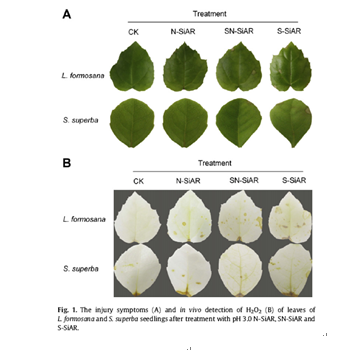Juan
Chen, Wen-Hua Wang, Ting-Wu Liu, Fei-Hua Wu, Hai-Lei Zheng*.Plant
Physiology and Biochemistry,2013.64: 41–51.
To study whether differential responses occur
in photosynthesis and antioxidant system for seedlings ofLiquidambar formosana,
an acid rain (AR)-sensitive tree species and Schima superba, an AR-tolerant
treespecies treated with three types of pH 3.0 simulated AR (SiAR) including
sulfuric-rich (S-SiAR), nitric-rich(N-SiAR), sulfate and nitrate mixed
(SN-SiAR), we investigated the changes of leaf necrosis, chlorophyllcontent,
soluble protein and proline content, photosynthesis and chlorophyll
fluorescence characteristics,reactive oxygen species production, membrane lipid
peroxidation, small molecular antioxidant content,antioxidant enzyme activities
and related protein expressions. Our results showed that SiAR
significantlycaused leaf necrosis, inhibited photosynthesis, induced superoxide
radical and hydrogen peroxide generation,aggravated membrane lipid
peroxidation, changed antioxidant enzyme activities, modifiedrelated protein
expressions such as Cu/Zn superoxide dismutase (SOD), L-ascorbate peroxidase
(APX, EC1. 11. 1. 11), glutathione S transferase (GST, EC 2. 5. 1. 18) and
Rubisco large subunit (RuBISCO LSU), alterednon-protein thiols (NPT) and
glutathione (GSH) content in leaves of L. formosana and S. superba.
Takentogether, we concluded that the damages caused by SiAR in L. formosana
were more severe and sufferedfrom more negative impacts than in S. superba.
S-SiAR induced more serious damages for the plants thandid SN-SiAR and N-SiAR.

返回

